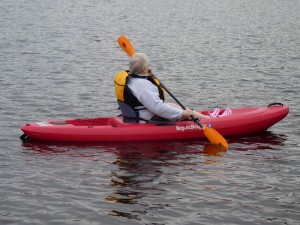
We love paddling, and, over a span of many years, we put a lot of mileage on our canoes. Then, a few years ago, we discovered kayaks. Particularly for a lone paddler, a kayak is faster, easier to steer, and, with its low profile, a whole lot easier to manage in a strong wind than a canoe. And, as you probably know if you’ve ever paddled one, they are a lot of fun.
So, we jumped right in and purchased a couple of one-person, 10-foot Wilderness Systems Pungo 100 kayaks. These are nice little craft, comfortable, stable, easy to paddle and great fun for exploring ponds, marshes and quiet rivers.
But there turned out to be a fly in the ointment: these are sit-in kayaks with a very low seat inside a cockpit, and, even though the cockpit on the Pungo kayaks is particularly spacious, Edie had a terrible time getting into and out of it. Now, if you’re a nimble and agile Active Senior, then a sit-in kayak like the Pungo might be just the ticket for you, but it didn’t work for Edie. It was a real ordeal for her, so after a while she pretty much gave up kayaking.
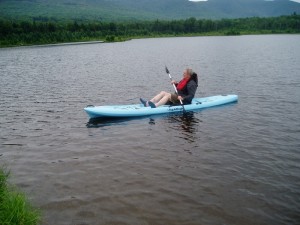
Tim Jones, our Executive Editor, heard about our plight. Now, Tim simply doesn’t accept any excuses for not getting outdoors and having fun, so he told us about something different in the kayak world, called a Sit On Top (SOT) kayak. He said SOTs are stable, easy to paddle, and much easier to get into and out of than a sit-in kayak, which makes them the perfect kayaks for seniors, and should solve Edie’s dilemma most handily.
This sounded intriguing, so we hied ourselves over to our friendly local kayak shop, Clearwater Sports in Waitsfield, Vermont, to try one of these critters. And if you’ve been wondering whether or not you might be able to get in and out of a kayak comfortably and otherwise manage an unfamiliar boat, read on!
Perfect Kayaks For Seniors from LiquidLogic
At Clearwater Sports we were taken in hand by Guy Dedell, who proved to be both exceedingly helpful and a veritable encyclopedia about the various types of kayaks. After some discussion, Guy recommended that Edie try a 10-foot “Coupe” by liquidlogic. For Warner, he suggested the liquidlogic “Versa Board.” This is also a SOT, but, as the name implies, it can be used in a number of different ways.
One advantage of these particular kayaks quickly became apparent: a small wheel, mounted under the stern as an integral part of the boat, makes it easy for one person to pick up the bow of the kayak and walk along with it. This is a real convenience, since you don’t have to heft the entire kayak and lug it to the water .
With the two kayaks mounted in our car racks, Guy directed us to nearby Blueberry Lake, a lovely pond located on the Green Mountain National Forest. When we arrived, one major difference between the Coupe and the Versa Board soon became apparent. The Coupe is short, light, and quite easy to handle. The Versa Board, on the other hand, is longer, wider, heavier, and much more awkward to put on or take off a car. We managed, however, and then easily rolled the two to the water, thanks to the built-in wheels.
Edie launched first. She began by trying to kneel on the deck of the Coupe, but then found that her quads just weren’t up to raising herself to sit on the seat. She next tried standing in the water, tipping the kayak towards her, and lowering herself onto the Deluxe seat (which swivels to the side–another nice touch). Voila! Even when tipped a great deal, the Coupe is very stable – much more so than our Pungos – so this method worked very well indeed for her. If you’re longing to try a kayak, but are afraid that you might have difficulty getting in and out of the deep cockpit of a conventional model, you owe it to yourself to try an SOT like this one!
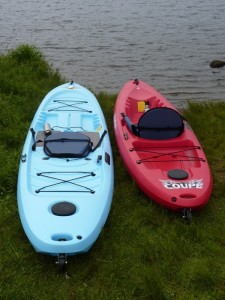
Happily ensconced on the seat, Edie began to paddle. At first, she was having trouble with the tracking, but then remembered another great innovation called a skeg (pronounced” skag”). This is a keel/rudder which is drawn up into the kayak until a little lever beside the paddler is flipped. Edie lowered the skeg, and immediately the kayak began to track beautifully! Another neat feature: the skeg is on a spring and pushes back up into the kayak to avoid damage if it encounters the bottom, a rock, or a sunken log. She also found that the series of slots on both sides of the kayak, in which the paddler’s feet are placed, was much easier to use than the adjustable foot rest in our Pungos. The Coupe, by the way, will handle Class 2 and 3 rapids for white water kayaking, and can also be used for sea kayaking; if you’re feeling adventurous, it won’t let you down!
At under $600 new, the Coupe seems very reasonably priced for a boat with this many features. The seat for the Coupe is not included in its price, however. The Deluxe seat is fairly costly, but Edie says that it’s easy to use and comfortable and well worth the extra money; you may want to check it out.
Warner then climbed aboard the Versa Board from the water, using the same technique that Edie had used with the Coupe, and took off into the lake. The Versa Board paddled nicely, and, with the skeg down, tracked very well. The Versa Board lives up to its name in at least three ways. First, it can be used just like an ordinary kayak. Second, there are a couple of non-slip places on either side of the seat so that someone can stand up and fish, and we were told that many fly fishermen use the Versa Board for that purpose. Warner’s sense of balance has never been great, and, because he wasn’t wearing a bathing suit he elected not to try standing and risk a ducking on a rather chilly day, but the idea is certainly intriguing. A third way that the Versa Board can be used is as a surf kayak. Thus, this very different looking kayak really is extremely versatile, and might be ideal for those who want a watercraft that will perform several different functions. The Versa Board, by the way, has the same excellent system of slots for the feet that the Coupe has.
Our trip around the little lake was most enjoyable. We saw a loon and lots of beaver paths leading from the surrounding woods down into the water. Edie also spotted a lovely pink lady slipper on the bank in a narrow inlet. With rain threatening, we paddled back to the landing and had just enough time to get the kayaks back on the car before the rain descended in earnest. It was a really fun little adventure, and we learned a great deal about kayaks in the process. By the way, Clearwater Sports also rents kayaks, provides kayaking instruction, and conducts guided kayak trips, so anyone interested in taking up kayaking can learn about it, and actually experience it, by contacting them; their e-mail is clearwatersport@madriver.com, telephone 802-496-2708.
Perfect Kayaks For Seniors from Hobie
Shortly after this trip, we learned of yet another SOT kayaking option (will wonders never cease?) These are paddle boats, but are propelled by your feet on pedals, much as a cyclist would pedal. If you’ve wanted to try kayaking, but have arm or shoulder problems that prevent wielding a conventional paddle effectively, one of these boats might be the ideal solution.
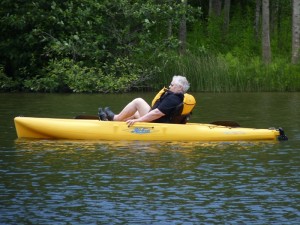
To try out these interesting craft, we visited Umiak Outdoor Outfitters in Stowe, Vermont, where we met manager Joe Henry. He proved to be as affable, helpful, and knowledgeable as his counterpart at Clearwater. One meets the nicest people in these ventures, and we can’t escape the feeling that they are at least as keen on helping others share their pleasure and enthusiasm as they are in making sales.
These pedal SOT kayaks have many excellent features; one of these was the outstanding stability that we’ve already mentioned with the kayaks that we had previously tested. Another was that they have two slots in the hull into which the struts for a pair of wheels can be inserted. These wheels are fairly good-sized (probably 10 inches or so in diameter), so that the kayak can be pulled very easily by one person. This kayak also has a slot in which the mast for a sail can be inserted, which makes it a more versatile craft.
Joe then pulled the kayak, a Mirage Sport by Hobie, out to a smallish pond behind the Umiak store. There, he proceeded to initiate us into the mysteries of a kayak propelled by pedals and underwater paddles (sort of like flippers). We took turns trying to get into it from the dock – with poor results for both of us. We found that the technique of standing in the water, rolling the kayak downward, sitting on the seat, and then lifting our legs up into the boat was far easier.
Once in the seat, you place your feet into the stirrups of a pair of pedals, and proceed to pedal much as you would a bicycle, or more accurately like using a stair-stepper at the gym. To do this, you lean back at a considerable angle, rather than sitting upright as one would with a more conventional kayak.
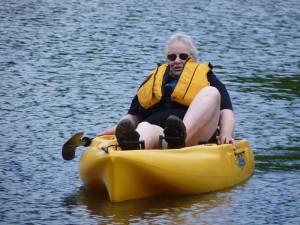
We found that these kayaks could be propelled quite fast, were very stable, and tracked well. Steering is also done with a rudder, which is controlled by a small lever. This takes a bit of adjustment in your thinking: sometimes it’s easy to forget and push the rudder lever the wrong way, although that can rapidly and easily be corrected. It was a most interesting experience to try to navigate using the pedals and rudder.
In the end, we both agreed that, for us, paddling in the conventional manner was more enjoyable. Somehow, leaning back at a substantial angle wasn’t as comfortable as the more conventional upright posture. Nevertheless, these kayaks can fill a definite need. As already mentioned, those who have various arm and/or shoulder problems that make conventional paddling difficult or impossible might head the list. Then there are skiers who want to keep their legs in shape during the offseason, as well as cyclists that might want another way of working their legs. Recumbent cyclists might especially appreciate this kayak. One minor disadvantage is the fact that the kayak can’t be pedaled backwards, so a standard paddle is carried in clips to guard against being stranded by such a contingency; imagine being stuck nose-in to some weeds and not being able to back up!
These kayaks do carry a hefty price tag, with the Mirage Sport coming in at $1549 (the paddle mechanism alone costs between $400 and $500). However, if this clever mechanism needs repair or adjustment, it can simply be pulled out very easily, worked on, and dropped back into place. The seat is included in the price of the kayak, but the pair of wheels on which to pull it cost extra.
Umiak Outdoor Outfitters also carries a variety of other types of kayaks, conducts guided kayak trips, and offers instruction, so it has a full range of services. They can be contacted by e-mail at www.umiak.com or by telephone at 802-253-2317.
The great news is that we found out that there are now many options available to us, and you, if you’re interested in taking up kayaking or want to update your kayak. These options allow people of widely ranging ages and physical conditions, including us Active Seniors, to enjoy a sport that can lead into all sorts of great opportunities and adventures. If you’re interested, find a knowledgeable kayak dealer, like the two that we dealt with, and start yakking about kayaks!
Postscript: Edie asked for and received a liquidlogic Coupe for her 75th birthday. More paddling adventures ahead!


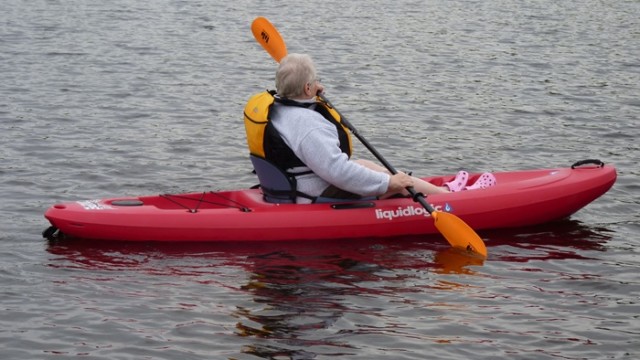
Nice promotion for Liquid Logic. I like the built in wheel and skeg features. However there are many alternatives for seniors who aren’t as flexible as they once were, especially with the growing popularity of raised “lawn chair-like” seating options and affordable stand-up assist straps (standard or an add on). Numerous kayak manufacturers market models that tout stability as well, primarily derived from the kayak being wider but also from how the hull is shaped. Many of these models are marketed as Fishing kayaks affording the ability to fish while standing and while seated up higher than in more traditional kayaks.. However the same kayak characteristics underlying fishing enhancements could be promoted to help with getting into and up out of the kayak and just being more comfortable to sit in as well. Just a few of the kayak companies that make such models include Feel Free, Jackson, Nucanoe, Old Town, and Pelican. If you are a senior, I suggest trying one or more of these before buying if possible at your local kayak dealer just to make sure it works for you. In addition, don’t underestimate consideration of how you will get the kayak to your destination and from your vehicle to the water. A light trailer designed for light watercraft such as kayaks is probably the easiest transport method but, of course, will be more involved and costly at the start. Enjoy your senior years!
Rich,
This has nothing to do with promoting Liquid Logic and everything to do with trying a new experience sand finding a solution to an obstacle that keeps you from doing something that you want to do but thought you couldn’t. In this case, the small, light LL Coupe fit the bill. Others will find other solutions — including larger, heavier kayaks transported on a trailer.
Your article was quite interesting and informative. I also liked Rick T’s comment to seniors lots of options to check out. thanks to both of you.
My dad invented a kayak stablization device that takes the fear of getting in and out of your kayak it is called the KayaArm. There are many videos on line and testimonials from our customers.